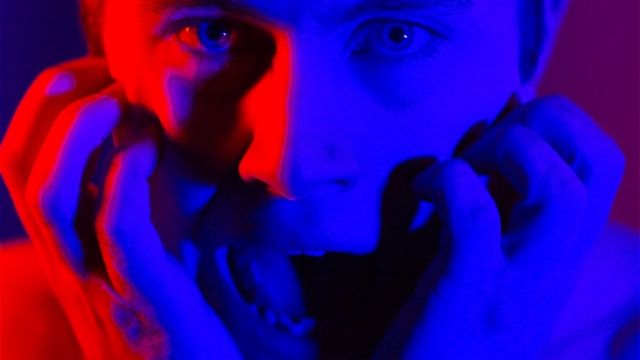Body Horror
The dominant colour is red – blood red. The ‘body’ of the title is assailed – in nightmare, in metaphor, in tangible anxiety, in visceral terror. Across ten segments, some with text, some a mixture of image, sound and music, we experience a variety of horrors. Bodies drip with blood and writhe in pain – or do they dance? Three ballet dancers lace up their toe shoes – which fill with and spill blood. A woman drowns in a pool filled with red balloons. A viola player is paralysed with the fear of being exposed as just not good enough. A woman in CU drinks blood and sings German lieder, the blood spilling and trickling down her chin…
The blurb for this online presentation tells us that it references – or is a homage to – 1970s and 1980s horror movies. That may not occur to all viewers, but one of the most powerful segments is of different women – again in CU – telling of – or confessing to – their responses to horror movies – and that means, I think, slasher movies. One speaks of the punishment of the ‘first girl’ trope, another of how the horror is a metaphor for violation in sick but possibly delicious surrender, how horror becomes sexualised, how the fear is eroticised and feeds desire.
In another segment, a single naked woman sits in a bath of what may or may be not blood and speaks direct to camera about rape – real, imagined, sanctioned - in fierce and sustained rage and about how she fantasises revenge.
It is interesting that of the ten segments, the most successful -, that is, powerful, packing a real punch - are those with text. The bloody dancing/writhing in all too ordinary rooms draped with plastic sheeting unfortunately looks a bit clumsy and naff. What do all those balloons mean really? What’s that blood on the limbs of some training athletes? Did they fall over? And who or what is the unseen assailant that knocks them down? For a such a brilliant visual stylist as director Stephen Nicolazzo, some elements here are puzzling.
Meanwhile, the women’s responses to horror movies are cleverly written, arresting and disturbing – some through mouthfuls of popcorn, a nice touch. The one exception – that is, with no text – and for me the most visceral and evoking real terror – is also the most ‘realistic’. It is highly subjective renderings of women walking home at night. There are night sounds – sharp, echoing, agitated footsteps along streets that might be empty - but what lurks in the bushes? A car horn… and a car that passes and then stops – all overlaid with music reminiscent of Bernard Herman’s score for Psycho. The ‘body horror’ here is the expectation of violation and worse.
The show ends with heartfelt protest, anxiety, and complaint by drama students about their futures – not only at the closure of drama departments across the country, but also at their own fears. Do they have a future? Have they learned anything anyway? Are they ready for the real, harsh world? What of arbitrary university grading? What of body image and stereotyping? It all comes back, inescapably, to bodies in the end.
Perhaps the uneven nature of Body Horror is due to the very large number of collaborators and participants (the names are all available online in the show’s online Program separate from the show itself). Some segments here are bewildering misfires, vague in intention and poor in execution. But then much is superbly acted and shot, inspired, gripping, profound, exploiting to the full the online medium – a tribute to the (precarious?) Sir Zelman Cowan School of Music & Performance – and Monash University School of Drama and Performance. Log on and see it.
Michael Brindley
Subscribe to our E-Newsletter, buy our latest print edition or find a Performing Arts book at Book Nook.

